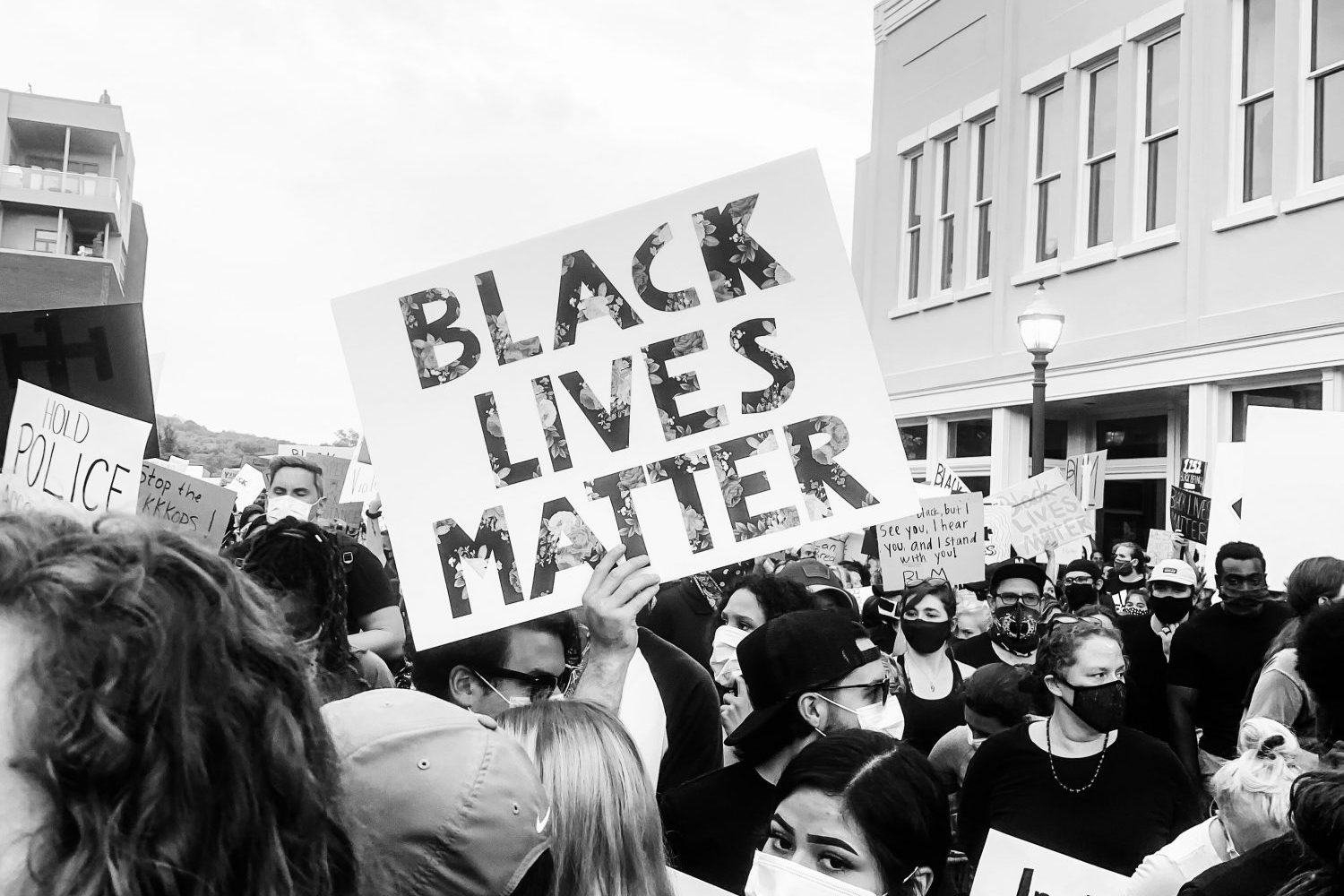Read this before you attend the protest this weekend.
Protesting is an important component of a functioning democracy. It provides an essential voice for minority groups, and periods of great upheaval have historically resulted in real, tangible change.
The recent murder of George Floyd at the hands of the Minneapolis police has sparked global outrage and people around the world are protesting to show their solidarity with the Black Lives Matter movement and to demand that our governments and police forces do better.
To be clear, the situation here in Australia in terms of what’s happening with the police and civilians is very different from America, and it is unlikely that the situation will escalate as it has done there. The below advice is about preparation – it’s not meant to incite fear.
This weekend, protests organised by Aboriginal communities are happening all around Australia in support of the Black Lives Matter movement. They are ways that all Australians can unite to demand an end to police brutality and black deaths in custody.
While the media coverage this week might make you think this is an issue unique to America, this is not the case. Australia’s history is shocking – 432 Indigenous Australians have died in custody since 1991, yet there hasn’t been a single conviction.
In places like Melbourne, tens of thousands of people have expressed an interest in protesting, and police are expecting crowds that will rival those of the annual Invasion Day rally, which drew around 80,000 people this year in Victoria.
You might have seen a lot of discussions online lately about the importance of taking your activism further than simply reposting resources on Instagram. Now is the time, particularly if you’re white or a non-black person of colour, to make good on your commitment to do better and to start actively practising being anti-racist.
But, unfortunately, we are in the midst of a pandemic, which makes the prospect of being in a huge crowd a lot more fraught with difficulties than usual. Not to mention, for some, this might be your first protest and you may be feeling confused and unsure about what to do or whether you’re legally allowed to be there given the current restrictions on gatherings of people.
Either way, a lot of people have questions, so we’ve endeavoured to answer as many as possible here to help prepare you for getting out there this weekend and fighting the good fight.
What should I wear and what do I need to bring?
Most importantly, make sure you have a mask or some type of covering over your face at all times. As we all know, even if you aren’t sick, you could be asymptomatic and we want to reduce transmission as much as humanly possible. Hand sanitiser is essential, and gloves are also a great idea.
Clothing and footwear wise, comfort is key. Check the weather forecast before going and wear weather-appropriate gear. You know the drill – pack sunblock and sunglasses if it’s going to be sunny and bring a rain jacket if rain is forecast. Wear shoes that you can walk for a long time in as protests often go on for several hours and involve a lot of walking.
It’s best that your shoes are closed-toe – sneakers are the way to go. As these protests are not going to be to the same scale and intensity as America’s, it’s unlikely you’ll need to run anywhere, but it’s good to be prepared.
Wear a crossbody bag or backpack and pack a water bottle, plenty of hand sanitiser and snacks if you think you’ll get hungry. Make a sign and bring it with you. This will help your friends find you if you get lost, and it’s also a great chance to express your solidarity with the movement. Ensure your phone is fully charged. If there’s any medication you need – hayfever tablets, an inhaler – make sure to bring it with you.
What about social distancing?
As much as you can, try to practice social distancing. This won’t be easy, but your best bet is attending the protest with a tight group that’s already within your bubble and keeping your distance from others as much as you can. It might be tempting to go alone, but protests can be pretty overwhelming to navigate by yourself, and it’s best to have someone with you in case things do turn sour.
Try to touch your face as little as possible, use hand sanitiser before and after touching anything, cough and sneeze into your elbow and avoid sharing food or drink with others. After the protest, change out of your clothes as soon as possible, wash them and take a shower. Disinfect all your belongings, and if possible, consider a two-week quarantine, or at the very least practise social distancing.
Monitor your symptoms carefully over the following weeks, and get tested if you start to feel unwell. This is probably stating the obvious, but if you’re unwell do not attend a protest. Instead, stay home and use the time to sign petitions, donate to relevant charities and self-educate.
Will we be arrested for gathering in a large group and breaking the law?
Victoria Police Deputy Commissioner Shane Patton has said that the organisers of Melbourne’s protest will be fined if more than 20 people turn up. But it was previously announced that police would use their discretion on the day when it comes to handing out fines so it would be a surprise to see mass fines being dealt.
Victorian Premier Daniel Andrews has stressed the importance of the protest remaining “peaceful”, saying, “The only form of legitimate protest is a peaceful protest”. Victoria Police has also confirmed there will not be a curfew on Melbourne’s CBD this weekend, but that protestors must adhere to social distancing rules as much as possible. Basically, if you wear a mask, stick with a small group and try to keep your distance from others – as much as is possible in a large crowd – you should be fine.
Make sure you keep up to date with information by checking out the Facebook event for the protest. Ultimately, you need to make the decision that feels right for you, but if you choose not to go, make sure you show your support virtually by sharing resources and donating.
Okay, so if I am arrested, what are my rights?
While it’s extremely unlikely that large-scale arrests will be made at the protests in Australia this weekend, it’s important to know your rights when it comes to the law, and to let others know their rights too. Laws vary state by state but in general, if the police have a reasonable belief you broke a law, they may place you under arrest.
In general activities, if the police ask you for your name, address or to see some identification, you don’t have to show them or tell them anything. However, if they have a reasonable belief that you have committed an offence or are about to do so, then you must give your name and address. The police need to tell you why they want your details and explain what it is they believe you or someone else may have done.
If you believe they don’t have a good reason to ask you, it can be safer to comply with their instructions and lay a complaint after the fact. By law, the police have to tell you their details if you ask, so remember to ask for their name, rank and place of duty and write it down so you don’t forget.
Unless you are arrested, you cannot be forced to attend an interview. Always ask if you are under arrest if they ask you to go to the station with them. If you’re not under arrest, you’re free to go. If you do get arrested, you have the right to call a lawyer or a friend or family member, and the police must tell you why they’re interviewing you. You have the right to remain silent and you don’t have to confirm anything in an interview except your name and address.
If you are a white person attending the protests, some have suggested using your body as a shield, in the instance that things do get heated. We’ve seen this happen in America, with chains of white people forming a barrier between the police and black people, and if it comes to it, it’s something that we should do here.
Remember though, the aim of these protests is to peacefully voice solidarity and demand changes in the treatment of Indigenous Australians in the justice system, so it’s not expected that it will be anything like what is happening in America right now.
Can I take photos? What’s the deal with metadata?
Before you pack your camera or decide to take photos or videos at the protest, ask yourself why you’re doing it. Don’t do it just to show that you were there – a protest is not something you do for the social clout. If you do decide to take photos, it’s important not to get anyone’s identifying features in the shot, and avoid taking photos of people’s faces unless you have their explicit consent.
There’s a lot of talk online about using specific apps to eliminate metadata from photographs, but much of this information is more relevant to what’s happening in America right now, where the police force and employers can identify and target protestors through photographs. Things have not escalated to that point here in Australia, but as a general rule of thumb be considerate and careful when taking photographs.
What if I lose the people I’m with?
It’s essential that you decide on an exit strategy or a meetup point with your group in the event that you do get separated. Do this prior to entering the crowd. This is where memorable signs can be handy if you get lost, so encourage your friends to get creative with the sign making.
Do I really need to go? It’s a pandemic, after all.
If you’re sick, immunocompromised or you live with people who are high-risk/immunocompromised, no, you need to stay at home. If you’re not sick but are worried you might have been exposed to coronavirus, you can make your contribution virtually through donations, signing petitions, self-educating and sharing relevant resources with your online and IRL community.
Otherwise, your presence is vital. Particularly if you are, like me, a white person. If you really don’t feel comfortable going, make sure you use the time to share resources and donate to relevant charities – a great selection of them are listed here.
Anything else I should keep in mind?
You are not there to lead – listen to the Indigenous Australians who will be leading the protests. You are there to stand in solidarity with the Black Lives Matter movement both here and abroad. You are there to express your disgust and outrage at a system that has resulted in 432 aboriginal deaths in custody since 1991, but zero convictions.
You are there to learn, and to realise that up to this point (most likely) you have not been doing enough. You have not taken enough direct action. You have not been explicitly anti-racist. The time for complacency is up – it was up long ago, but for many of us, our privilege has allowed us to be complacent for far, far too long. Stand strong and look after each other. Check-in with your black friends and if you have the means to, pay the rent and donate.
The Stop Black Deaths in Custody rally is happening on Saturday June 6 from 2pm and will meet at Parliament House steps at 1 Spring Street, Melbourne CBD. For more information, visit the Facebook event page.
A national-focused version of this story appeared in Fashion Journal.

